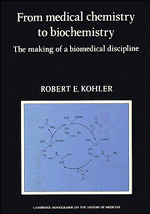Book contents
- Frontmatter
- Contents
- 1 Introduction: On discipline history
- 2 Physiological chemistry in Germany, 1840–1900
- 3 Physiology and British biochemists, 1890–1920
- 4 General biochemistry: the Cambridge school
- 5 European ideals and American realities, 1870–1900
- 6 The reform of medical education in America
- 7 From medical chemistry to biochemistry: the emergence of a discipline
- 8 Unity in diversity: the American Society of Biological Chemists
- 9 The clinical connection: biochemistry as applied science
- 10 Chemical ideals and biochemical practice
- 11 Biological programs
- 12 Epilogue: Toward a molecular biology?
- Location of archival sources and abbreviations
- Notes
- Index
10 - Chemical ideals and biochemical practice
Published online by Cambridge University Press: 07 October 2011
- Frontmatter
- Contents
- 1 Introduction: On discipline history
- 2 Physiological chemistry in Germany, 1840–1900
- 3 Physiology and British biochemists, 1890–1920
- 4 General biochemistry: the Cambridge school
- 5 European ideals and American realities, 1870–1900
- 6 The reform of medical education in America
- 7 From medical chemistry to biochemistry: the emergence of a discipline
- 8 Unity in diversity: the American Society of Biological Chemists
- 9 The clinical connection: biochemistry as applied science
- 10 Chemical ideals and biochemical practice
- 11 Biological programs
- 12 Epilogue: Toward a molecular biology?
- Location of archival sources and abbreviations
- Notes
- Index
Summary
The influence of chemistry in biochemistry may seem as amorphous and boundless a theme as the influence of theology in the church. At the beginning, nearly a third of the members of the American Society of Biological Chemists had Ph.D. degrees in chemistry. Half of ASBC members who got their degrees between 1900 and 1910 joined the American Chemical Society; no fewer than 85% of the cohort with doctorates between 1930 and 1934 did so. It is rare to find biochemists who did not take their undergraduate work in chemistry. Most chemists regarded biochemistry as an applied branch of their discipline, and their views enjoyed increasing deference from biochemists. How, then, to dissect such a close-woven tissue of relationships? As in the preceding chapter, we must concentrate on institutionalized roles and channels of influence. We must see what systematic opportunities there were for recruitment of chemists or for cooperative relations. We must see how adoption of chemists' theories and methods conferred strategic advantages for discipline building. We must understand how chemists' disciplinary ambitions and their role in medical school departments shaped the practice of biochemistry.
The language of “hybrid” disciplines should not mislead us into assuming that chemistry and biology or medicine had equal or symmetrical roles in the genesis and nurture of biochemistry. In fact, they did not. Biology and medicine provided problems; chemistry provided means. (Chemical means did tend, of course, to become biochemical ends.) Few biochemists came from backgrounds in biology or the biomedical sciences; chemistry was the principal source of recruits.
- Type
- Chapter
- Information
- From Medical Chemistry to BiochemistryThe Making of a Biomedical Discipline, pp. 253 - 285Publisher: Cambridge University PressPrint publication year: 1982



